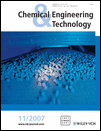Continuous Laboratory Gold Solvent Extraction from Cyanide Solutions using LIX 79 Reagent
Abstract
Continuous laboratory solvent extraction of gold from cyanide solutions has been investigated by using LIX 79 guanidine-based extractant. Different variables that affected the extraction included aqueous pH, extractant concentration and modifier concentration. Extraction isotherms of the aurocyanide complex with respect to the other cyanoanions were compared, and the following order of selectivity was observed: Au > Ag > Cu > Zn > Fe. According to the pH isotherms, aurocyanide can be extracted in alkaline media, and a better separation with respect to other cyano anions was obtained in the pH range 10.5–11.2. From the McCabe-Thiele diagrams, better recovery was observed when using LIX 79 and tridecanol at 10 vol.-%. Stripping gold from the loaded organic was carried out at pH > 12 by using NaOH and NaCN solutions. The pilot plant tests indicate that a two-stage extraction followed by one strip step are more than adequate to obtain an overall process efficiency of 92 %. However, for those cases where copper is present significantly, a copper wash stage is recommended before gold stripping. In this case, stripping of copper is accomplished at a pH 10.8, whereas the gold stripping was done at a pH of 12.0.




